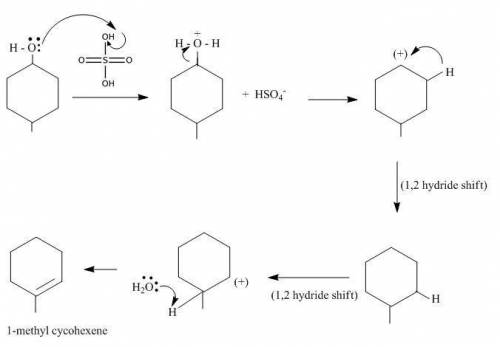
Chemistry, 30.11.2019 00:31 jhaveen8335
While the reaction in the lab text gives the product 4-methylcyclohexene, it is possible that several products are formed in this reaction, including 1-methylcyclohexene, because of 1,2-hydride shifts in the carbo-cation intermediate. show a step-wise, arrow-pushing mechanism for the formation of 1-methylcyclohexene.

Answers: 1


Another question on Chemistry

Chemistry, 22.06.2019 03:30
Nanotechnology, the field of trying to build ultrasmall structures one atom at a time, has progressed in recent years. one potential application of nanotechnology is the construction of artificial cells. the simplest cells would probably mimic red blood cells, the body's oxygen transporters. for example, nanocontainers, perhaps constructed of carbon, could be pumped full of oxygen and injected into a person's bloodstream. if the person needed additional oxygen-due to a heart attack perhaps, or for the purpose of space travel-these containers could slowly release oxygen into the blood, allowing tissues that would otherwise die to remain alive. suppose that the nanocontainers were cubic and had an edge length of 24 nanometers. part a part complete what is the volume of one nanocontainer? (ignore the thickness of the nanocontainer's wall.) express your answer using two significant figures. v v = 1.4ă—10â’20 l previous answers correct significant figures feedback: your answer 1.3824â‹…10â’20 = 1.382ă—10â’20 l was either rounded differently or used a different number of significant figures than required for this part. if you need this result for any later calculation in this item, keep all the digits and round as the final step before submitting your answer. part b suppose that each nanocontainer could contain pure oxygen pressurized to a density of 81 g/l . how many grams of oxygen could be contained by each nanocontainer?
Answers: 3


Chemistry, 22.06.2019 22:40
Covalent bonds generally form when the bonded elements have a difference in electronegativity less than 1.5. subtract the electronegativities for the following pairs of elements and predict whether they form a covalent bond. electronegativity difference of c and c: ionic covalent electronegativity difference of mg and cl: ionic covalent
Answers: 1

Chemistry, 23.06.2019 00:00
If many scientists conduct the same or similar experiments, and all obtain similar results, a can be written, which is a generally agreed-upon statement that explains and predicts how a natural phenomenon works.
Answers: 1
You know the right answer?
While the reaction in the lab text gives the product 4-methylcyclohexene, it is possible that severa...
Questions


History, 05.02.2020 01:45

Advanced Placement (AP), 05.02.2020 01:45

English, 05.02.2020 01:45


Geography, 05.02.2020 01:45

Mathematics, 05.02.2020 01:45





Social Studies, 05.02.2020 01:45

Mathematics, 05.02.2020 01:45

Mathematics, 05.02.2020 01:45


Mathematics, 05.02.2020 01:45



Biology, 05.02.2020 01:45

Mathematics, 05.02.2020 01:45




